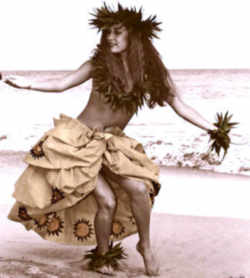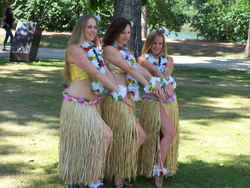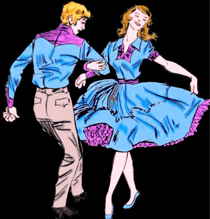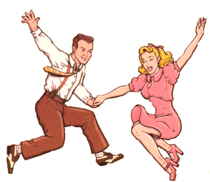
Hawaii Symbols
Hawaii State Dance
Hula

Adopted in 1999.
Hula was adopted in 1999 as the official dance of the state.
Hula is a uniquely Hawaiian dance accompanied by chant or song that preserves and perpetuates the stories, traditions and culture of Hawaii. Hawaiian
legends tell stories of hula beginning on the islands of Molokai and Kauai. Today, this enchanting art form has become a worldwide symbol of Hawaiian
culture and the beauty of Hawaii's people. The popularity of hula has spread to the U.S. mainland, Japan and even Europe.
There are many types and styles of hula. Hula auana (modern hula) is danced to western influenced music and features a more modern and fluid style.
This is the most familiar type of hula to visitors. Hula kahiko (ancient hula) is danced to dramatic chants and percussion with more traditional costumes.
Hawaii State Dance: Hula

Hula is the soul of Hawaii expressed
in motion. Molokai is Hawaiian in another special way: It is widely held to be the birthplace of hula. The legend has it that Laka, the goddess of
the hula, journeyed from island to island, sharing the dance with all who wished to learn. Each of her graceful movements was layered with spiritual
meaning, bringing to life the history, traditions and genealogy of the Hawaiian people. Although it began as a form of worship during religious ceremonies,
it gradually evolved into a form of entertainment.
Laka gave birth to the Hawaiian dance at a sacred hill in Kaana. It was on this hill, Puu Nana, that the ancient Hawaiians learned hula of every kind.
It is said that the remains of Laka herself are secretly hidden somewhere beneath the hill.
Every movement in hula has a specific meaning, and every expression of the dancer's hands has great significance. The movements of a dancer's body
might represent certain plants, animals, and even war.
During the 19th century, the hula almost vanished because the missionaries considered it vile and heathen. King David Kalakaua is generally regarded
as saving it during the late 1800's, when he formed his own troupe and encouraged the dancers to learn the old hula.
Today, several hundred halau hula (hula schools) and less formal hula groups are active on every island and the mainland, teaching hula to thousands
of students and keeping the old ways and traditional Hawaiian culture alive.
Hawaii Law
The law designating the Hula dance as the official Hawaii state dance is found in the Hawai`i Revised Statutes, Volume 1, Chapter 5, Section 5-21
Volume 1.
CHAPTER 5. EMBLEMS AND SYMBOLS.
SECTION 5-21
[§5-21] State dance. Hula is adopted, established, and designated as the official dance of the State. [L 1999, c 83, §2]







